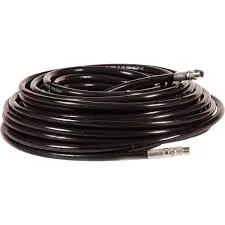Essential Guide to Power Wash Hose Selection and Maintenance Tips
The Importance of a Quality Power Wash Hose
In the realm of cleaning solutions, power washing stands out as one of the most efficient methods for maintaining the cleanliness and appearance of various surfaces. Whether it’s a driveway, patio, or the exterior of a house, power washing can help remove dirt, grime, and even stubborn stains. However, the effectiveness of power washing heavily relies on not only the machine itself but also the quality of the power wash hose being used.
A power wash hose plays a crucial role in determining the success of any pressure washing task. It connects the pressure washer to the nozzle, carrying water at high pressure to unleash a powerful jet that can cut through layers of dirt and debris. When selecting a power wash hose, one must consider several key factors including material, length, diameter, and pressure rating.
First and foremost, the material of the power wash hose is paramount. Most hoses are made from either PVC (polyvinyl chloride) or rubber. PVC hoses are lightweight and less expensive, making them a common choice for casual users. However, they can be less durable and more susceptible to kinks and wear. On the other hand, rubber hoses are more robust and flexible, able to withstand higher temperatures and pressures, making them ideal for heavier use or professional settings. Investing in a high-quality rubber hose can enhance both performance and longevity, proving to be more cost-effective in the long run.
power wash hose

The length of the hose is another critical aspect to consider. Power wash hoses typically range from 25 to 100 feet, and the choice should be based on the specific cleaning tasks at hand. A longer hose provides greater reach and versatility, allowing users to access hard-to-reach areas without having to move the pressure washer constantly. However, users should also be aware that longer hoses may reduce the pressure output slightly due to friction loss, which is why it’s essential to balance length with performance requirements.
Diameter also affects water flow and pressure. Power wash hoses generally come in various diameters, with 1/4 inch being the most commonly used for light-duty tasks and 3/8 inch for heavy-duty applications. The larger the diameter, the more water can flow through the hose, resulting in more powerful cleaning capabilities. Therefore, understanding the specific requirements of your pressure washer, including its flow rate and pressure, is vital to selecting the correct hose size.
Finally, the pressure rating of the hose is a non-negotiable factor to ensure safety and efficiency. Each hose comes with a maximum working pressure rating, which must be higher than the output of the pressure washer being used. Using a hose that cannot withstand the pressure can lead to bursts or leaks, putting the user at risk and damaging the equipment.
In conclusion, the choice of a power wash hose is critical to the overall effectiveness of pressure washing. By considering factors such as material, length, diameter, and pressure rating, users can ensure they select a hose that not only meets their cleaning needs but also withstands the rigors of frequent use. Investing time and effort into choosing the right power wash hose will ultimately lead to cleaner surfaces and a more satisfying power washing experience. Whether you are a homeowner looking to maintain your property or a professional cleaner seeking reliable equipment, don’t underestimate the importance of a quality power wash hose in achieving your cleaning goals.
-
Ultimate Spiral Protection for Hoses & CablesNewsJun.26,2025
-
The Ultimate Quick-Connect Solutions for Every NeedNewsJun.26,2025
-
SAE J1401 Brake Hose: Reliable Choice for Safe BrakingNewsJun.26,2025
-
Reliable J2064 A/C Hoses for Real-World Cooling NeedsNewsJun.26,2025
-
Heavy-Duty Sewer Jetting Hoses Built to LastNewsJun.26,2025
-
Fix Power Steering Tube Leaks Fast – Durable & Affordable SolutionNewsJun.26,2025

